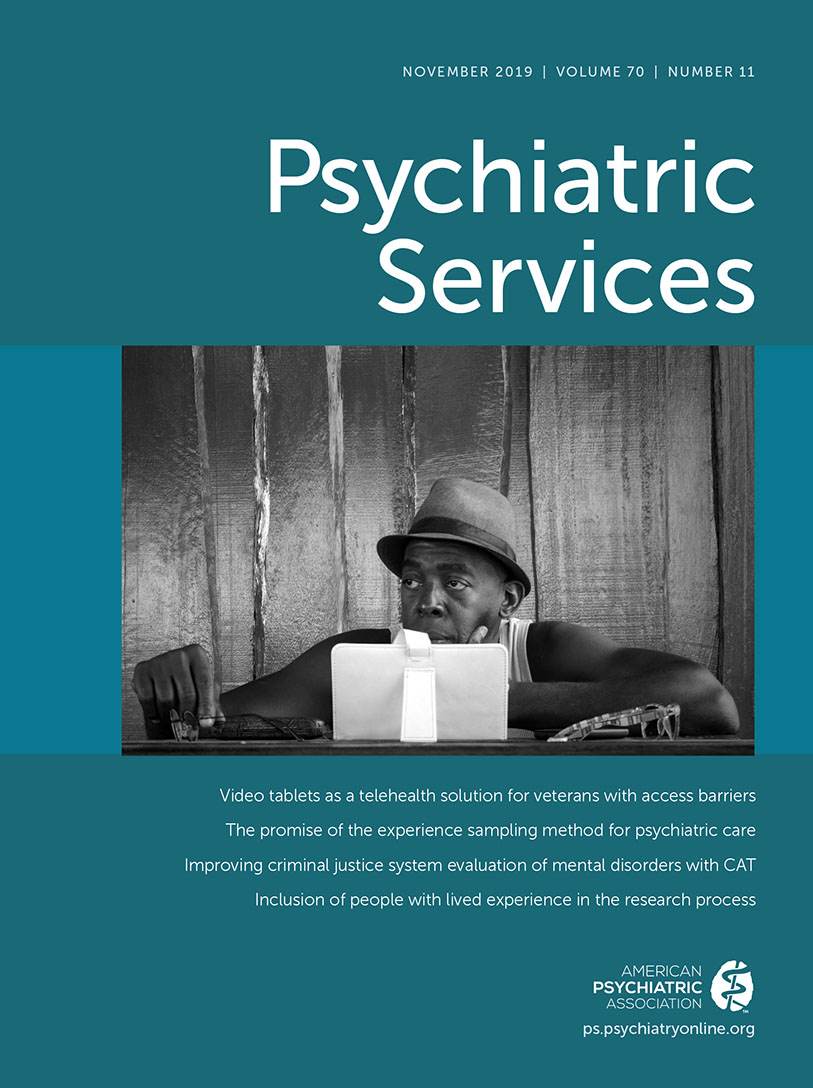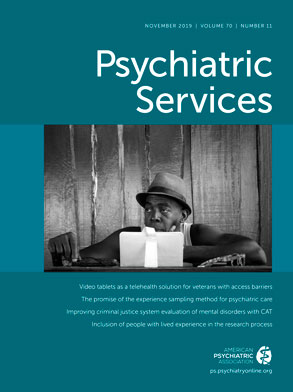Use of Drug Treatment Services Among Adults With Opioid Use Disorder: Rates, Patterns, and Correlates
Abstract
Objectives:
Methods:
Results:
Conclusions:
HIGHLIGHTS
Methods
Data Source and Study Sample
Measures
Drug-related health services use.
Sociodemographic characteristics.
Behavioral comorbidities.
Data Analysis
Results
Rates and Patterns of Drug-Related Health Services Use

Sociodemographic Characteristics and Service Use
| Used drug-related health services | ||||
|---|---|---|---|---|
| Yes | No | Total | Bivariate | |
| Characteristic | (N=148) | (N=1,330) | (N=1,478) | OR |
| Age | ||||
| 18–44 (reference) | 70.8 | 75.1 | 74.7 | |
| 45–64 | 28.3 | 21.2 | 21.9 | 1.41 |
| ≥65 | 1.0 | 3.7 | 3.4 | .29 |
| Gender | ||||
| Male (reference) | 56.9 | 61.0 | 60.6 | |
| Female | 43.1 | 39.0 | 39.4 | 1.19 |
| Race-ethnicity | ||||
| Non-Hispanic white (reference) | 67.6 | 61.9 | 62.5 | |
| Non-Hispanic black | 17.4 | 18.0 | 18.0 | .88 |
| Hispanic | 12.0 | 15.0 | 14.7 | .73 |
| Other racial-ethnic group | 3.1 | 5.1 | 4.9 | .55 |
| Marital status | ||||
| Married (reference) | 12.4 | 21.7 | 20.8 | |
| Never married | 44.0 | 48.7 | 48.2 | 1.59 |
| Otherb | 43.7 | 29.6 | 31.0 | 2.59** |
| Family income | ||||
| <$20,000 (reference) | 54.3 | 41.5 | 42.7 | |
| $20,000–$39,999 | 22.4 | 25.7 | 25.4 | .66 |
| ≥$40,000 | 23.3 | 32.8 | 31.9 | .54 |
| Employed (reference: no) | 62.9 | 73.9 | 72.8 | .60* |
| Education | ||||
| Less than high school (reference) | 21.0 | 16.4 | 16.9 | |
| High school or equivalent | 38.5 | 30.1 | 30.9 | 1.00 |
| Some college | 34.9 | 39.3 | 38.9 | .69 |
| Bachelor's degree or higher | 5.6 | 14.2 | 13.4 | .31* |
| Insurance coveragec | ||||
| Private | 32.2 | 42.9 | 41.9 | .63 |
| Medicare | 22.4 | 14.9 | 15.6 | 1.65 |
| Medicaid | 32.9 | 18.6 | 20.0 | 2.14** |
| Otherd | 28.0 | 34.9 | 34.2 | .73 |
| Uninsured | 29.7 | 25.6 | 26.0 | 1.23 |
| Disability income support (reference: no) | 24.2 | 13.0 | 14.1 | 2.13*** |
| Region | ||||
| Northeast (reference) | 25.1 | 17.7 | 18.4 | |
| Midwest | 22.3 | 19.7 | 20.0 | .80 |
| South | 32.5 | 34.4 | 34.2 | .67 |
| West | 20.1 | 28.2 | 27.5 | .50* |
| Residence | ||||
| Rural (reference) | 22.0 | 16.0 | 16.6 | |
| Urban | 78.0 | 84.0 | 84.4 | .68 |
Behavioral Comorbidities and Service Use
| Used drug-related health services | ||||
|---|---|---|---|---|
| Yes | No | Total | Bivariate | |
| Variable | (N=148) | (N=1,330) | (N=1,478) | OR |
| Past-year opioid use disorder | 41.3 | 21.1 | 23.1 | 2.64*** |
| Pain | ||||
| Never or a little (reference) | 68.1 | 68.1 | 68.1 | |
| Moderately, quite a bit, or extremely | 31.9 | 31.9 | 31.9 | 1.00 |
| Health-related quality of life mental component summary (M±SD score) | 40.7±12.4 | 44.0±12.0 | 43.7±12.1 | .98* |
| Past-year psychiatric disorder | ||||
| Any | 63.3 | 47.6 | 49.1 | 1.90** |
| Major depressive disorder | 30.1 | 26.8 | 27.1 | 1.17 |
| Dysthymia | 10.0 | 10.3 | 10.2 | .97 |
| Bipolar 1 disorder | 21.4 | 7.4 | 8.7 | 3.40*** |
| Generalized anxiety disorder | 19.2 | 14.4 | 14.9 | 1.41 |
| Posttraumatic stress disorder | 26.5 | 16.9 | 17.8 | 1.77* |
| Panic disorder | 16.3 | 9.6 | 10.2 | 1.85* |
| Past-year substance use disorder | ||||
| Alcohol | 55.2 | 53.8 | 53.9 | 1.06 |
| Any illicit drug | 86.1 | 85.8 | 85.8 | 1.02 |
| Cannabis | 44.2 | 68.2 | 65.9 | .37*** |
| Sedative | 20.8 | 8.5 | 9.7 | 2.83** |
| Cocaine | 22.0 | 7.7 | 9.0 | 3.40*** |
| Stimulant | 22.5 | 6.8 | 8.3 | 3.98*** |
| Heroin | 23.7 | 1.2 | 3.4 | 25.11*** |
| Hallucinogen | 4.5 | .9 | 1.3 | 5.08** |
| Inhalant-solvent | .7 | 1.1 | 1.1 | .62 |
| Club drug | 6.3 | 2.7 | 3.1 | 2.39 |
| Tobacco | 77.7 | 60.0 | 61.7 | 2.33** |
Factors Associated With Drug-Related Health Services Use
| Factor | AOR | 95% CI |
|---|---|---|
| Opioid use disorder diagnosis (reference: other illicit drug use disorder diagnosis) | 2.43** | 1.38–4.28 |
| Age | 1.01 | .99–1.03 |
| Female (reference: male) | 1.01 | .65–1.57 |
| Race-ethnicity (reference: non-Hispanic white) | ||
| Non-Hispanic black | .81 | .46–1.43 |
| Hispanic | .96 | .50–1.84 |
| Other racial-ethnic group | .64 | .24–1.74 |
| Marital status (reference: married) | ||
| Never married | 1.78 | .75–4.19 |
| Otherb | 2.12 | 1.05–4.31 |
| Family income (reference: <$20,000) | ||
| $20,000–$39,999 | .81 | .47–1.40 |
| ≥$40,000 | .76 | .41–1.42 |
| Employed (reference: no) | .85 | .48–1.52 |
| Education (reference: less than high school) | ||
| High school or equivalent | 1.17 | .62–2.21 |
| Some college | .88 | .47–1.65 |
| Bachelor's degree or higher | .51 | .14–1.83 |
| Insurance coverage (reference: no) | .83 | .51–1.36 |
| Disability income support (reference: no) | 1.64 | .95–2.81 |
| Region (reference: Northeast) | ||
| Midwest | .75 | .39–1.46 |
| South | .62 | .34–1.12 |
| West | .54* | .32–.91 |
| Urban residence (reference: rural) | .74 | .42–1.30 |
| Pain felt moderately, quite a bit, or extremely (reference: never or a little bit) | .47* | .27–.84 |
| Health-related quality of life mental component summary | .99 | .97–1.01 |
| Any psychiatric disorder (reference: no) | 1.46 | .87–2.44 |
| Alcohol use disorder (reference: no) | 1.00 | .59–1.70 |
| Tobacco use disorder (reference: no) | 1.65 | .94–2.90 |
| Factor | OR | 95% CI | AOR | 95% CI |
|---|---|---|---|---|
| Age | .96** | .94–.99 | 1.00 | .96–1.04 |
| Female (reference: male) | .71 | .36–1.39 | .69 | .30–1.57 |
| Race-ethnicity (reference: non-Hispanic white) | ||||
| Non-Hispanic black | .20*** | .10–.42 | .22** | .08–.63 |
| Hispanic | .73 | .29–1.81 | 1.22 | .35–4.23 |
| Other racial-ethnic group | .10* | .01–.80 | .19 | .01–2.43 |
| Marital status (reference: married) | ||||
| Never married | 4.48** | 1.61–12.45 | 5.02* | 1.31–19.24 |
| Otherb | 1.76 | .58–5.31 | 1.24 | .37–4.12 |
| Family income (reference: <$20,000) | ||||
| $20,000–$39,999 | .49 | .21–1.15 | .88 | .32–2.40 |
| ≥$40,000 | .78 | .31–1.95 | 1.40 | .53–3.71 |
| Employed (reference: no) | 1.63 | .71–3.76 | 1.10 | .42–2.89 |
| Education (reference: less than high school) | ||||
| High school or equivalent | 1.08 | .49–2.40 | .87 | .31–2.44 |
| Some college | 1.14 | .49–2.69 | 1.11 | .33–3.80 |
| Bachelor's degree or higher | .07* | .01–.62 | .11 | .01–1.70 |
| Insurance coverage (reference: no) | .29*** | .14–.57 | .35* | .14–.86 |
| Disability income support (reference: no) | .61 | .29–1.30 | 1.29 | .37–4.49 |
| Region (reference: Northeast) | ||||
| Midwest | .95 | .26–3.44 | 1.76 | .49–6.30 |
| South | 1.19 | .37–3.87 | 1.60 | .47–5.50 |
| West | .58 | .17–1.97 | .87 | .26–2.91 |
| Urban residence (reference: rural) | .86 | .41–1.83 | .65 | .24–1.72 |
| Pain felt moderately, quite a bit, or extremely (reference: never or a little bit) | .48* | .24–.96 | 1.04 | .37–2.98 |
| Health-related quality of life mental component summary | 1.00 | .96–1.03 | 1.01 | .97–1.05 |
| Any psychiatric disorder (reference: no) | 1.97 | .87–4.43 | 1.79 | .72–4.40 |
| Alcohol use disorder (reference: no) | 1.26 | .62–2.56 | .55 | .23–1.30 |
| Any additional illicit drug use disorder (reference: no) | 4.07*** | 1.99–8.30 | 2.66* | 1.07–6.63 |
| Tobacco use disorder (reference: no) | 3.93** | 1.65–9.38 | 1.87 | .62–5.61 |
Discussion and Conclusions
References
Information & Authors
Information
Published In
History
Keywords
Authors
Competing Interests
Metrics & Citations
Metrics
Citations
Export Citations
If you have the appropriate software installed, you can download article citation data to the citation manager of your choice. Simply select your manager software from the list below and click Download.
For more information or tips please see 'Downloading to a citation manager' in the Help menu.
View Options
View options
PDF/EPUB
View PDF/EPUBLogin options
Already a subscriber? Access your subscription through your login credentials or your institution for full access to this article.
Personal login Institutional Login Open Athens loginNot a subscriber?
PsychiatryOnline subscription options offer access to the DSM-5-TR® library, books, journals, CME, and patient resources. This all-in-one virtual library provides psychiatrists and mental health professionals with key resources for diagnosis, treatment, research, and professional development.
Need more help? PsychiatryOnline Customer Service may be reached by emailing [email protected] or by calling 800-368-5777 (in the U.S.) or 703-907-7322 (outside the U.S.).

